
The Grote Kerk or St.-Bavokerk is a Reformed Protestant church and former Catholic cathedral located on the central market square in the Dutch city of Haarlem. Another Haarlem church called the Cathedral of Saint Bavo now serves as the main cathedral for the Roman Catholic Diocese of Haarlem-Amsterdam.
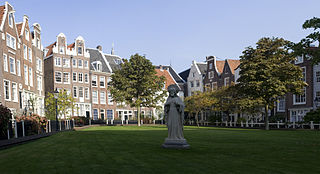
The Begijnhof is one of the oldest hofjes in Amsterdam, Netherlands. A group of historic buildings, mostly private dwellings, centre on it. As the name suggests, it was originally a béguinage. Today it is also the site of two churches, the Catholic Houten Huys and the English Reformed Church.

Caspar Barlaeus was a Dutch polymath and Renaissance humanist, a theologian, poet, and historian.

Ons' Lieve Heer op Solder is a 17th-century canal house, house church, and museum in the city center of Amsterdam, The Netherlands. The Catholic Church was built on the top three floors of the canal house during the 1660s. It is an important example of a "schuilkerk", or "clandestine church" in which Catholics and other religious dissenters from the seventeenth century Dutch Reformed Church, unable to worship in public, held services. The church has been open as a museum since 28 April 1888, and has 85,000 visitors annually.
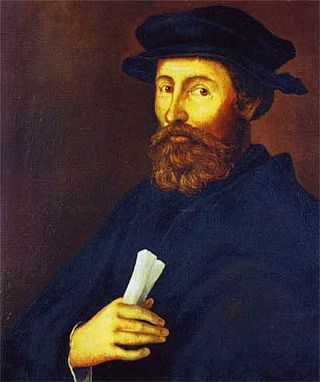
DirkPietersz Crabeth was a Dutch Renaissance glass painter, tapestry designer, and mapmaker. He was employed by the Janskerk (Gouda) during the 16th century, where he created eight of the stained glass windows during the years 1555–1571. His windows are one of the reasons that the church was placed on the UNESCO list of monuments.

The Nieuwezijds Voorburgwal is a street in the centre of Amsterdam. The street runs north-south without intersecting major streets other than the intersection with Raadhuisstraat at its halfway point, right behind the Royal Palace. On the eastern side, it has a number of alleys connecting to Kalverstraat and Nieuwendijk.
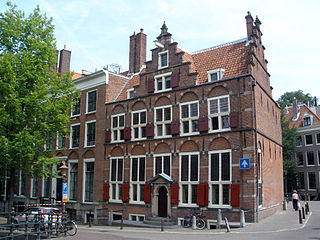
The Huis aan de Drie Grachten or Huis op de Drie Grachten is a 17th-century canal house in Amsterdam, at the southeastern end of the Wallen district. The name is a reference to the fact that the building faces three different Amsterdam canals. The south facade faces Grimburgwal, the west facade faces Oudezijds Voorburgwal and the east facade faces Oudezijds Achterburgwal. The address is Oudezijds Voorburgwal 249.
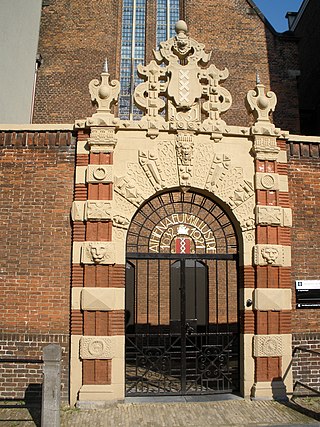
Athenaeum Illustre, or Amsterdamse Atheneum, was a city-sponsored 'illustrious school' founded after the beeldenstorm in the old Agnieten chapel on the Oudezijds Voorburgwal 231 in Amsterdam, Netherlands. Famous scientists such as Caspar Barlaeus, Gerardus Vossius, Martinus Hortensius, Alexander de Bie, and Petrus Camper taught here.
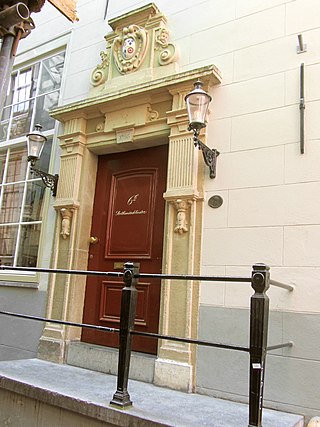
The Bethaniënklooster is a former 15th-century monastery in the Wallen area of Amsterdam. It is one of the few remains of the once-expansive area of monasteries that dominated the oudezijde of town in the Middle Ages. The monastery was devoted to Mary of Bethany and, at its largest extent, encompassed the entire area between Bloedstraat and Oude Hoogstraat streets to the north and south and Oudezijds Achterburgwal and Kloveniersburgwal canals to the west and east.

Amsterdam University Library is the library of the University of Amsterdam (UvA) and the Academic Medical Centre (AMC). The central complex of the Library is in the town centre at Singel, close to Heiligeweg and Koningsplein. The Library's Special Collections are housed nearby at Oude Turfmarkt, next to UvA's Allard Pierson Museum. The Library also has a large book depot in the grounds of the AMC, with over 40.5 kilometers of books and other materials. The foundation Friends of the Library of the University of Amsterdam regularly donates special manuscripts or rare editions to the library collection.

The Walloon Church is a Protestant church building in Amsterdam, along the southern stretch of the Oudezijds Achterburgwal canal. The building dates to the late 15th century and has been in use as a Walloon church since 1586. The church was also known as the Franse Kerk, Walenkerk, Oude Walenkerk, or Oude Waalse Kerk.
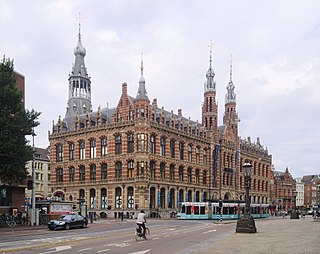
The former Amsterdam Main Post Office, now the Magna Plaza shopping centre, is a monumental building located at Nieuwezijds Voorburgwal 182 in Amsterdam, Netherlands. It was built in 1895–1899 in neo-Gothic and neo-Renaissance style. The building has been a rijksmonument since 9 July 1974, and is part of the Top 100 Dutch heritage sites.

The Shipping House is a building on the western tip of the Waalseiland near Amsterdam harbour that is one of the top 100 Dutch heritage sites and generally regarded as the first true example of the Amsterdam School, a style characterised by "expressive dynamism, lavish ornamentation and colourful embellishments". It is situated on the Prins Hendrikkade and was erected on the spot where Cornelis Houtman's first trip to the East Indies had begun in 1595. The first part was built 1913 - 1916 ; the second part was built 1926 -1928. Originally, it was the headquarters of six leading Amsterdam shipping companies: the Netherlands Steamship Company (SMN), the Royal Packet Navigation Company (KPM), the Java-China-Japan Line (JCJL) and the Royal Dutch Steamboat Company (KNSM) with subsidiary New Rhine Navigation Company (NRM) and acquired in 1912 Royal West India Mail Service (KWIM).

The Handboogdoelen is a building on the Singel canal in Amsterdam, near Koningsplein square. It dates back to the early 16th century and originally served as headquarters and shooting range of the local schutterij. Most of the current building at Singel 421 dates to the 18th century and is part of the main complex of the Amsterdam University Library. The Doelenzaal hall on the ground floor of the building is used for lectures, meetings, receptions and doctoral dissertations. The building has rijksmonument status.

Grote of Jacobijnerkerk is a Protestant church in the city of Leeuwarden, Netherlands. The square surrounding the church is the Jacobijnerkerkhof.

The Oudezijds Voorburgwal, often abbreviated to OZ Voorburgwal, is a street and canal in De Wallen in the center of Amsterdam. It runs from the Grimburgwal in the south to the Zeedijk in the north, where it changes into the Oudezijds Kolk, which drains into the IJ.

The Grimburgwal is a small canal and street in the center of Amsterdam.

The Oudezijds Achterburgwal, often abbreviated to OZ Achterburgwal, is a street and canal in De Wallen, the red light district in the center of Amsterdam.
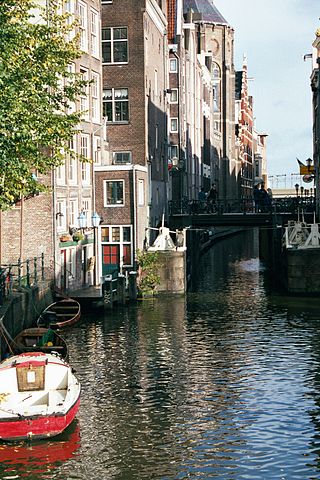
The Oudezijds Kolk is a short and narrow canal/lock in Amsterdam between the Oudezijds Voorburgwal and the Oosterdok.

The Spuistraat in downtown Amsterdam connects the Hekelveld to the Spui. It runs roughly north to south, parallel to the Singel and the Nieuwezijds Voorburgwal. At the Royal Palace of Amsterdam, the Spuistraat crosses the Raadhuisstraat and Paleisstraat. Originally the Spuistraat was a canal, the Nieuwezijds Achterburgwal. The canal was filled up in 1867, and the street was then renamed.




























